
2014 marks Art Basel Hong Kong's second anniversary. This year's premier edition will trace twelve decades of art history across four sectors: Galleries, Insights, Discoveries, and Encounters. Over 50% of the galleries participating will come from Asia-Pacific, making this festival the best way to access the region's hottest artists all in one place.
Imperial Tours and Mandarin Oriental are teaming up once again to enable you to enjoy Art Basel Hong Kong in style. We have created an itinerary which offers VIP Access to Art Basel and as well as the chance to experience the intrigue of Hong Kong. This package for two includes:
This Art Basel Hong Kong Itinerary can be customized in any way, from adding additional nights to incorporating other unique Hong Kong experiences, like taking high tea with a fortune teller or employing a personal shopper to help you find hidden gems. We can also have one of our art experts accompany you through the festival or to galleries and exhibitions ancillary to the festival.
If you are going all the way to Hong Kong, why not make a quick hop over to Shanghai or Beijing before or after the fair? More great art can be found in both destinations. And if you are spending fewer than 72 hours in either destination, you don't need to obtain a visa.
To view our Art Basel Hong Kong itinerary, please click here. If you'd like to book this trip as is or have us customize it to suit your needs, please send an email to web_inquiry@imperialtours.net.
 China has been a world superpower twice already, and in the near future it is set to have a major impact both on our lives and those of our children and grand-children. So then, given its relevance, doesn’t it make perfect sense as a destination for a family trip? Just because you’re on vacation does not mean that your holiday can’t be educational and eye opening. Bring your kids to China over spring or summer break and expose them to the country’s history and culture as well as its modern development. Let them visit with the founder of a hi-tech business incubator that is fusing contemporary art, technology and business in a creative new setting. Or else, have them tour Tiananmen Square with a former freedom fighter to understand China’s road to economic reform and its evolving political relationship with its people. Tour a Shanghai university with a scholar to compare Eastern and Western educational systems; find out how science, technology, engineering and math (STEM) are taught differently here and why these subjects are stressed in Chinese culture.
China has been a world superpower twice already, and in the near future it is set to have a major impact both on our lives and those of our children and grand-children. So then, given its relevance, doesn’t it make perfect sense as a destination for a family trip? Just because you’re on vacation does not mean that your holiday can’t be educational and eye opening. Bring your kids to China over spring or summer break and expose them to the country’s history and culture as well as its modern development. Let them visit with the founder of a hi-tech business incubator that is fusing contemporary art, technology and business in a creative new setting. Or else, have them tour Tiananmen Square with a former freedom fighter to understand China’s road to economic reform and its evolving political relationship with its people. Tour a Shanghai university with a scholar to compare Eastern and Western educational systems; find out how science, technology, engineering and math (STEM) are taught differently here and why these subjects are stressed in Chinese culture.
While these may all be experiences you want for your child, if you were to ask what his or her dream trip would entail, would it include holding a baby panda or taking a ping pong lesson with a former Olympic coach? Or maybe it would involve a bike ride on an ancient city wall or flying a kite on the Great Wall of China.
So is a trip to China fun or educational? The answer, of course, is both.
Imperial Tours has put together a sample Spring or Summer Break Trip to China for families of three or four. Feel free to customize this trip in whatever way you wish to suit your traveling style, duration, family size or interests. Contact us to tailor an itinerary specifically designed for your immediate or multi-generational family.
Anyone with an interest in food, wine and entertaining, will be excited that Imperial Tours is offering a 6 night private culinary trip through Shanghai and Hangzhou Nov 27 – Dec 3, 2013 in conjunction with the Park Hyatt Shanghai's annual "Masters of Food and Wine Festival".
The itinerary for two incorporates the following highlights:
• VIP airport meet and greet including Diplomatic Channel access
• 4 Nights at the Park Hyatt Shanghai
• 2 Nights at the Four Seasons Hangzhou
• Contemporary art and expert-led colonial architecture tours of Shanghai
• Private club, West Lake, Buddhist temples and tea specialist tour in Hangzhou
• Champagne class with Ned Goodwin, Master of Wine from Tokyo
• Gala dinner presented by Two Star Michelin Master Chef Jean-Luc Rocha from Chateau de Corbeillan-Bages
• Floral design class by French Master Florist Sebastien Lathuile and Park Hyatt Master Florist Emily Zhou
• Closing gala dinner hosted by Three Star Michelin Chef Anne-Sophie Pic of Maison Pic.
High end foodies will not want to miss this trip! Imperial Tours is able customize this itinerary in any way to suit travelers' needs. For a slightly longer itinerary, we can suggest pairing it with some holiday shopping in either Shanghai or Beijing, or both!
For questions or a copy of the itinerary with pricing, please email Priscilla Tan in our Shanghai office.

When booking the Waldorf Astoria Shanghai on the Bund through Imperial Tours, you will receive these special amenities:
And to entice families to visit China this summer, when booking the Waldorf Astoria Shanghai on the Bund for travel between May 1 and August 31, 2013, families with children under 15 years of age will receive a second room at half price. Shanghai is a great place for children and Imperial Tours has some wonderful Imperial Moments for families:
Contact Us to learn more about the Waldorf Astoria Shanghai on the Bund or about family travel in China.
Why take home a taxi-load of anonymous self-assembly flat-pack furniture, when for much the same price you can fill your apartment with elegant traditional Chinese pieces?

(This article is for information purposes only. Imperial Tours is not in involved in any capacity with the antique or reproduction furniture business. Our links page introduces various Chinese and western furniture websites. We have no business relationship with these websites, and our links are not to be interpreted as recommendations. We advise caution when contacting these companies.)
 Opening the door to your astronomically-priced expat housing, you are appalled by the gaudiness of the furniture inside. It's so out of date that even your grandmother would smile in embarrassment. Tensions rise to the surface when visitors drop by – friends, colleagues…your boss. Is there any way of silencing their grating offers of sympathy, or of replacing their latent discomfort with open admiration?
Opening the door to your astronomically-priced expat housing, you are appalled by the gaudiness of the furniture inside. It's so out of date that even your grandmother would smile in embarrassment. Tensions rise to the surface when visitors drop by – friends, colleagues…your boss. Is there any way of silencing their grating offers of sympathy, or of replacing their latent discomfort with open admiration?
Fortunately, there is.
Beijing is replete with sophisticated furniture sellers and skilled craftsmen, whose ready services can be employed to restore your interiors to elegant grace. But before you rush to a furniture maker, equipped with your sketch of a swimming-pool-sized daybed, or to Guang Han Tang Antiques, credit card in hand, you should prime yourself with some background information. This will mark you out as a knowledgeable rather than a naive customer.
Categories of furniture
To tilt the shopkeeper's opinion in your favor, you should start by identifying furniture pieces by their proper names. Chinese furniture began to take its present form during the Northern Song Dynasty. Since then the following terminology has been used, as shown in the table below:
| Chinese homophone | English | Special characteristics | Image |
| Stools | |||
| Dengzi | Stool, bench | Square, rectangular or round |
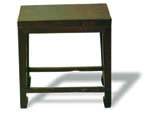 |
| Zuodun | Stool | Barrel-shaped stool |
 |
| Jiaoyi | Folding chair | Seats made of rattan |
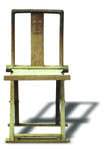 |
| Chinese homophone | English | Special characteristics | Image |
| Chairs | |||
| Fushouyi | Armchair |
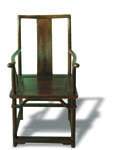 |
|
| Kaobeiyi | Yolk-back chair | Without armrests |
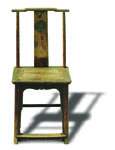 |
| Guanmaoyi | Official's hat chair | Top of backrest has wings like an official's hat |
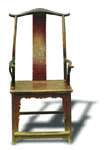 |
| Quanyi | Horse-shoe chair | Back is horse-shoe shaped |
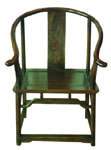 |
| Chinese homophone | English | Special characteristics | Image |
| Tables | |||
| Tiao'an | Entrance table | Long and narrow |
 |
| Hua'an Shuan | Writing table | Wider than entrance table |
 |
| Kangzhuo | Bed table | Small in size & low |
 |
| Fangzhuo | Square table |
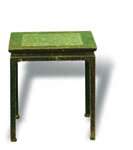 |
|
| Huaji Xiangji | Plant stand, incense stand | Long and high legs |
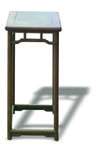 |
| Chinese homophone | English | Special characteristics | Image |
| Shelves | |||
| Jiage | Storage shelf |
 |
|
| Chinese homophone | English | Special characteristics | Image |
| Cabinets | |||
| Yuanjiaogui | Round-sided cabinet |
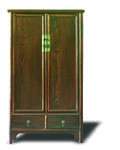 |
|
| Fangjiaogui | Square-sided cabinet |
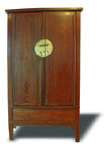 |
|
| Chinese homophone | English | Special characteristics | Image |
| Beds | |||
| Ta | Daybed | No sides |
 |
| Luohanchuang | Opium Bed | Has three sides; resembles a couch |
 |
| Jiazi chuang | Canopy Bed | Wooden canopy encloses bed |
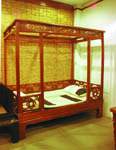 |
In ensuing discussions, you may also find the following vocabulary helpful:
Useful words and phrases
| Chinese Homophone | English | Chinese Homophone | English |
| Chang | long | Changdu | length |
| Kuan | wide | Kuandu | width |
| Gao | high | Gaodu | height |
| Hou | thick | Houdu | thickness |
| Shen | dark | Shendu | darkness |
| Qian | light |
Not all woods are made equally
Crucial to the price and quality of your furniture is the wood used for it.
Recently, we had the pleasure of walking through a Hebei forest with Laurent Colson, a Parisian antique dealer. Indicating the various trees around us, he explained which wood was esteemed during each dynastic period to manufacture the various categories of furniture. Only if, like him, you trade at esoteric levels of the antique market do you need such encyclopedic knowledge. For most of us, it is enough to know which woods are the traditional signifiers of high quality furniture.
The table below presents the characteristics of the most commonly used woods. Grades 1-4 (grade 1 is the best) designate the hardwoods while grades 5-7 designate the lesser quality and more commonly available softwoods.
| Chinese homophone | English | Colour | Characteristics | Grade |
| Zitan | Red Sandalwood | Reddish-brown to golden-yellow | Shimmering surface with abstract patterns | 1 |
| Huanghuali | Yellow Rosewood | Blackish-purple to blackish-red | Fine, lustrous surface | 2 |
| Jichimu | Chicken-wing Wood | Deep brown | Brown, gray patterns resembling feathers | 3 |
| Tieli | Iron Wood | Grayish black | Coarse texture | 4 |
| Hongmu | Chinese Mahogany | Reddish-brown to blackish-red | Used only after the 18th century | 5 |
| Nanmu | Evergreen Laurel | Olive-brown to reddish-brown | Shimmering surface, smooth texture | 5 |
| Hetao | Walnut | Golden-brown to reddish-brown | Open-grained texture; fragrant | 6 |
| Jumu | Southern Elm | Yellowish-brown to coffee-brown | Medullary rays; feathery patterns | 6 |
| Zuomu | Oak | Grayish-yellow to grayish-brown | Medullary rays; lustrous flakes | 6 |
| Yumu | Northern Elm | Yellowish-brown to chestnut-brown | Layered, feather-like patterns | 7 |
| Zhangmu | Camphor | Reddish-brown | Light/dark striped pattern; strong fragrance | 7 |
Hardwoods
Zitan (red sandalwood) and Huanghauli (yellow rosewood), the premier hardwoods, were traditionally sourced from Hainan Island, but now are also available from other tropical parts of Southeast Asia. Jichimu (chicken-wing wood) and Tieli (iron wood) come from Fujian and Guangdong provinces.
Hardwood furniture, however, was not necessarily manufactured near its source. Just as important as the woods' geographic distribution, was the availability of craftsman skilled enough to work them. For instance, the best Huanghuali furniture was known to hail from Jiangsu province, because specialist craftsmen during the Ming and Qing dynasties (mid-15th to early-20th centuries) assembled there to work with it.
Softwoods
Typically these are woods easily sourced by local craftsmen. Since they are readily available, they are used for more common pieces of furniture. They comprise the bulk of furniture in today's market, ranging from Yumu (northern elm) and Huaimu (locust)-in the northern provinces of Hebei and Shanxi-to Jumu (southern elm)-in Jiangsu province-and Xiangzhang (camphor)-in the south.
Let the shopping begin!
Notwithstanding that a little knowledge-especially when backed with good credit-is a dangerous thing, let's go shopping. You have three purchasing routes open to you. Firstly, to buy genuine antiques, secondly to purchase reproductions, and lastly to organize the design and purchase of your own made-to-order furniture. The price comparisons below give only a general indication of the prices of comparable objects. Prices listed are not exact and, of course, do not include the discounts able negotiators may be able to obtain.
| Furniture category | Antique | Reproduction | Made to order |
| Opium Bed |
US$1,800+ |
US$1,200 (Northern Elm) |
US$360 (Northern Elm) |
| Horse-shoe chair |
US$850+ (Northern Elm) |
US$600 (Northern Elm) |
US$100 (Northern Elm) |
| Dining table & chairs (8) |
US$2,500+ (Northern Elm) |
US$1,800 (Northern Elm) |
US$1,800 (Northern Elm) |
| Armoire |
US$1,200+ (Southern Elm) |
US$400 (Northern Elm) |
US$360 (Northern Elm) |
Tips for buyers
Antiques
If you are interested in the top end of this market, the first thing to note is that Beijing does not necessarily offer the most reasonable prices. At this level, prices are set internationally. You should compare prices at Guang Han Tang and Hua Yi with dealers located in Hong Kong, New York, Paris and London.
Otherwise, there are two laws well worth knowing. Firstly, if a Chinese dealer misrepresents an antique, i.e. sells you a fake instead of the real thing, under article 49 of the PRC's Consumers' Rights Law, you are entitled to a penalty of at least double the value of the sale. Secondly, when it comes to leaving the country-you are legally obliged to have your purchased antiques valued by the Customs Office (something which most international moving companies will arrange for you). Chinese law stipulates that antiques which are older than 300 years are not allowed to be exported out of the country. This law, however, does not apply to all woods, but to the more valuable zitan, huanghuali and jichimu woods. As laws do change, it is advisable that you confer with the store to make sure that you will be allowed to take your purchases home.
Although most antique stores will guarantee the quality of their goods, the value of such warranties is negligible once you have left the country.
Reproduction
The main thing to watch out for when in the market for reproduction furniture is to verify that the piece has been made using aged wood ("lao mu" in Mandarin Chinese). If the wood is more than eighty years old, it will have dried properly. Consequently, during winter when all woods contract, the resulting separation will be kept to a minimum. Should your furniture crack down the middle of a panel, this is a clear sign that new wood was used.
If, however, a certain degree of separation occurs at the junction of two or more panels, do not worry. This is to be expected.
Made to order
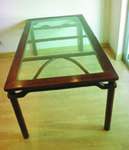 If you aren't a trained designer, the easiest way of going about this process is to first purchase a design or photographic book of Chinese furniture. While there are numerous coffee table books, one of the most useful is Illustrated Chinese Furniture Through the Ages by Ruan Chanjiang (ISBN 7-5344-0233-6/J234). This book contains line drawings of many of the pieces, featuring not only the various categories of furniture but also numerous stylistic variations for each particular category. Another good reference book is Illustrated Chinese Furniture of the Ming Dynasty by Jing Ronghua and Shuai Ciping (ISBN 7-5038-2393-3/TB0318) which has photographs of some of the more popular pieces of Ming dynasty furniture. Both books can be found in Liulichang.
If you aren't a trained designer, the easiest way of going about this process is to first purchase a design or photographic book of Chinese furniture. While there are numerous coffee table books, one of the most useful is Illustrated Chinese Furniture Through the Ages by Ruan Chanjiang (ISBN 7-5344-0233-6/J234). This book contains line drawings of many of the pieces, featuring not only the various categories of furniture but also numerous stylistic variations for each particular category. Another good reference book is Illustrated Chinese Furniture of the Ming Dynasty by Jing Ronghua and Shuai Ciping (ISBN 7-5038-2393-3/TB0318) which has photographs of some of the more popular pieces of Ming dynasty furniture. Both books can be found in Liulichang.
One advantage to buying made-to-order furniture is that you can adapt pieces according to your particular needs. For instance, traditional Chinese dining sets are often enormous in size, suitable for the spacious courtyards homes of the Ming and Qing elite, but perhaps not as suitable for the tiny New York apartment which may one day house them. In addition to such practical changes as customizing the dimensions, you may want to alter pieces according to your aesthetic preferences. For instance, a traditional dining table may be adapted by using a glass table top rather than a wooden one (see left), or the design of a mirror made to mimic the decorative motif of the more traditional entrance table(see right).

One word of caution-Beijing furniture makers, for obvious reasons, are better at making traditional Chinese styles. Taking a copy of Architectural Digest or Elle Decor and expecting them to copy the Western or modern designs is not recommended. Also beware that ordering your own furniture typically involves a great deal of supervision. Mr. Hou Xiaodong, for instance, will always let you inspect the structure of the piece before varnishing it. Once you've approved the structure, he will ask you to specify the color of the varnish. (This usually involves looking around his storage room for one that you like.) And before delivering the final product, he will invite you to inspect the piece a last time to approve the varnish. Though this process may sound tedious, it is advisable to invest as much care and interest in inspecting your furniture as you would expect him to do in manufacturing it.
Lastly, to care for your furniture, do not clean it with a spray-on furniture polish or with a wet cloth. Wipe it regularly with a dry cloth, and every 3 months apply a high-quality furniture wax such as Manson Wax.
By so doing, you will not only assure your own continuing satisfaction, but that of your friends, colleagues, and perhaps even your boss. Happy shopping.
Guy Rubin and Nancy Kim are the founders of Imperial Tours. They can be contacted via web_inquiry@imperialtours.net. Laurent Colson runs his antique furniture business from Galerie Luohan, 21 quai Malaquais, 75006 Paris.
July 20-August , 2000 CITY WEEKEND
(All photographs © City Weekend)
 From tailored suits to diamonds to contemporary Vietnamese art, Hong Kong can provide for every price range and quality. As this tropical island was formerly a British colony, English is widely spoken and it is not hard to get around on your own, whether by MTR, taxi or rented limo. Whilst many will be interested to wander along Cat Street or visit the Bird & Jade market to view Chinese curiosities, others armed with shopping guides, magazine cut-outs and friends' recommendations will venture deep into this commercial hub on their own. Such expeditions are great fun and must of course be elaborated to become the stuff of legend when you return home.
From tailored suits to diamonds to contemporary Vietnamese art, Hong Kong can provide for every price range and quality. As this tropical island was formerly a British colony, English is widely spoken and it is not hard to get around on your own, whether by MTR, taxi or rented limo. Whilst many will be interested to wander along Cat Street or visit the Bird & Jade market to view Chinese curiosities, others armed with shopping guides, magazine cut-outs and friends' recommendations will venture deep into this commercial hub on their own. Such expeditions are great fun and must of course be elaborated to become the stuff of legend when you return home.
Imperial Tours offers a variety of shopping options for visitors to Hong Kong , depending on guests' needs. Please ask our sales staff for more information.
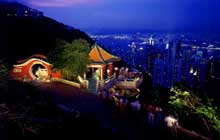 Victoria Peak
Victoria Peak
If you picture Hong Kong as a dragon, with qi or energy coursing through it, then Victoria Peak is the summit of the dragon's spine; and the Peak is unquestionably Hong Kong 's premier tourist site. If you visit in summer you'll no doubt sympathize with Sir Richard MacDonnell, a Governor of Hong Kong in the nineteenth century, who moved his residence there to avoid the tropical torpor down by the harbor. Since Sir Richard's day a few more buildings have gone up and it is no longer a simple look-out, but a multi-storey complex of shops, restaurants, and a Madame Tussaud's waxworks (with Jackie Chan, of course). But it's the view that one goes for. Day or night the vista over the harbor, with the buildings slowly crawling up the hill toward you, is breathtaking. You can drive to the Peak, or join many other tourists on the funicular (a cable railway with two cars balancing each other as they move in opposite directions) that runs at such an angle that it is difficult to believe that Hong Kong 's buildings are vertical and not shooting out at all angles. From the terminus you can take the escalators to the top viewing platform.
Government House
Built in 1855 and extended by the Japanese during their four years of rule in Hong Kong this charming neo-classical building served as the residence for 25 of Hong Kong 's Governors. When the British left in 1997 the building was abandoned, but beginning in 2006 the building resumed its purpose. Now it once again houses Hong Kong's political leader, this time the Chief Executive of the SAR who would, no doubt, sympathize with the sentiment of the British Governor of 1919-25, Sir Reginald E Stubbs, who advised keeping any leanings of the local population toward democracy 'within the bounds of reason'. It remains to be seen whether it will host the luminaries it has in days gone by, counting among its visitors the yet to be crowned Tsar Nicolas II, and the former US President Ulysses Grant.
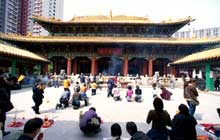
The Tin Hau and Man Mo Temples
One of the most striking facets of Hong Kong is that a city that appears so thoroughly modern preserves so many small temples and functions as one of the de facto centers of the Chinese art of Feng Shui. The two worlds may not be as separate as they appear and many of Hong Kong 's landmark buildings have been designed with feng shui principles in mind. None of the buildings, however, can compete with a site near the Lung Cheung Road Lookout, on the Kowloon Peninsula , where they say the dragon energy that has ensured Hong Kong 's success is thickest. To get a feel for the original culture that flourishes yet in Hong Kong then visit a Tin Hau or Hung Sin Temple, both being gods of the sea. The Tin Hau Temple in Causeway Bay , built initially in the early eighteenth century, is still in the hands of the family who put it up. Just around the corner is the Lotus Temple – a terrific example of a small local temple where if you back up to admire the view you'll bump into a pillar. The Lotus Temple has monks, the delightful coiled cone incense, and is a fine place to see how ancestor worship, religious worship, and scholarship all come together – in this Buddhist temple, in the spirit of Pascal's Wager, there is also a statue of Confucius in one of the side temples on the way up. The best-known Daoist temple is the Man Mo Temple, a Hong Kong landmark that is popular with everyone, regardless of whether they are Daoist or not. The Temple was constructed during the middle of the nineteenth century and dedicated to the twin gods of literature and the martial arts – a telling sign of how important those two attributes became in Chinese culture is that positions in the imperial governments were often divided along those lines; and if you place the Chinese characters for 'literature' and 'martial' side by side the resultant character means refined.
The Outlying Islands
If you feel like escaping the concrete and skyscrapers in search of an older Hong Kong then the outlying islands make for an interesting experience. Many preserve a way of life that is almost unimaginable amidst the offices in Central. From Cheung Chau with its still functioning fishing village to Lantau with its exhilarating walks on well-defined trails, and quaint villages. The scenery can be stark on the slopes yet tropically lush by the shore – wherever you walk you'll soon enough come face to face with the realization that Hong Kong 's extraordinary growth has come about despite lacking supplies of fresh water and arable land. Lantau is also home to the largest Buddha in the area, known unsurprisingly as the Big Buddha, which can now be visited via an extraordinary cable-car journey that begins near the airport and winds its way for nearly 6km up to the Po Lin Monastery. In a curious Western juxtaposition, that Hong Kong seems so good at throwing up, Lantau boasts both a Disneyland and a Trappist Monastery; the latter used to make fresh milk, known as 'Priest Milk', on site.
 Just to the south of Hong Kong lies Macao. This tiny territory of just under thirty square kilometres must be one of the few places in the world where a former colony boasts a higher per capita income than the parent country. Macao was settled while the Portuguese were acting as middlemen for trade between the Chinese and Japanese during the sixteenth century. These days it is internationally known for the casinos, whose revenues now better those of Las Vegas , but beneath that all-encompassing industry a small segment of Europe has lived on inside the Chinese world.
Just to the south of Hong Kong lies Macao. This tiny territory of just under thirty square kilometres must be one of the few places in the world where a former colony boasts a higher per capita income than the parent country. Macao was settled while the Portuguese were acting as middlemen for trade between the Chinese and Japanese during the sixteenth century. These days it is internationally known for the casinos, whose revenues now better those of Las Vegas , but beneath that all-encompassing industry a small segment of Europe has lived on inside the Chinese world.
The British poet, Auden, visited many years ago and wrote a poem which began:
"A weed from Catholic Europe, it took root
Between the yellow mountains and the sea,
And bore these gay stone houses like a fruit,
And grew on China imperceptibly."
And finishes with a line that Auden presumably meant as a slight "And nothing serious can happen here", but which may have helped preserve some of the charm and tastes of the Portuguese world. These range from the ruins of the Church of St. Paul and a cemetery through which you can trace the history of the settlement, to the foods be they simple bread or substantial Macanese fare.
Some of the numerous gaming revenues that the small territory which, like Hong Kong , has reverted to China , has been put to good use in providing public services and expanding the university.
FOR IMMEDIATE RELEASE
November 18, 2008
|
Contact : Heather Caufield |
Amy Benson |
 |
Dumplings & Dynasties
The James Beard Foundation Celebrates the Evolution of Modern Chinese Cuisine with Annual Gala Dinner/Auction and Two-Day Conference.
New York, NY (November 18, 2008) – The James Beard Foundation celebrated the evolution of modern Chinese cuisine last Thursday at Dumplings & Dynasties, a gala dinner and fundraising auction. The exceptional banquet of modern Chinese fare prepared by guest chefs from China and North America for over 240 people at The Edison Ballroom raised funds for the James Beard Foundation. Following the gala, the Foundation hosted a two-day conference featuring experts on the food and culinary culture of China.
The evening began with a dim sum reception created by Terrence Chan of Lai Wah Heen at the Metropolitan Hotel in Toronto. The banquet dinner was prepared by Chen Jun of Peninsula Restaurants in Shanghai; Richard Chen of Wing Lei at Wynn Las Vegas; Chow Chung of Chow Chung Restaurant in Hong Kong; JBF Award Winner Susanna Foo of Susanna Foo in Philadelphia; Susur Lee of Madeline's and Lee in Toronto and Shang by Susur Lee in New York City; Patrick Lin of Metropolitan Hotels in Toronto and Vancouver; Terrence Chan and Ken Tam of Lai Wah Heen at the Metropolitan Hotel in Toronto; with support from Joe Ng of Chinatown Brasserie in New York City. Wine and beverage pairings for each course were chosen by guest sommelier Joshua Wesson. The event's décor was created by Marc Wilson of Marc Wilson Design.
Notable guests included Ming Tsai, B.D. Wong, Vivienne Tam, Daniel Boulud, Joe Bastianich and Gael Greene. The event featured once in a lifetime live auction packages, including an auction lot sold for $26,000 that included dinner for 12 at Shang by Susur Lee with Champagne pairings by Nicolas Feuillatte and Oysters from Taylor Shellfish Farms of Shelton, Washington, plus a dazzling pearl and diamond necklace from Mikimoto for the hostess. The top selling package of the evening was a seven-day gourmet excursion for two to China, provided by Imperial Tours and courtesy of Valerie Wilson Travel with Delta BusinessElite airfare for two to Shanghai, which sold for $30,000. In all, the silent and live auctions raised more than $160,000 to support the James Beard Foundation's mission and programs.
The James Beard Foundation's 2008 Conference on Cuisine and Culture on Friday, November 14, and Saturday, November 15 featured a day of presentations, panels, and discussions with experts from around the world on a wide range of topics, followed by a day of experiential learning activities designed to give participants an opportunity for hands-on education.
Sponsors
The Dumplings & Dynasties events were sponsored by Delta Air Lines, Metropolitan Hotels, Lee Kum Kee, Saveur Magazine, Acqua Panna® Natural Spring Water, Mikimoto, S.Pellegrino® Sparkling Natural Mineral Water with cultural partners Asian/Pacific/American Institute at NYU and Asia Society, and event partners Astor Center, Chinatown Brasserie, Savory Productions and TMI Trading – Chef.
About the James Beard Foundation
Founded in 1986, the James Beard Foundation is dedicated to celebrating, preserving, and nurturing America's culinary heritage and diversity in order to elevate the appreciation of our culinary excellence. A cookbook author and teacher with an encyclopedic knowledge about food, James Beard, who died in 1985, was a champion of American cuisine. He helped educate and mentor generations of professional chefs and food enthusiasts. Today, the Beard Foundation continues in the same spirit by administering a number of diverse programs that include educational initiatives, food industry awards, scholarships to culinary schools, and publications, and by maintaining the historic James Beard House in New York City's Greenwich Village as a "performance space" for visiting chefs.